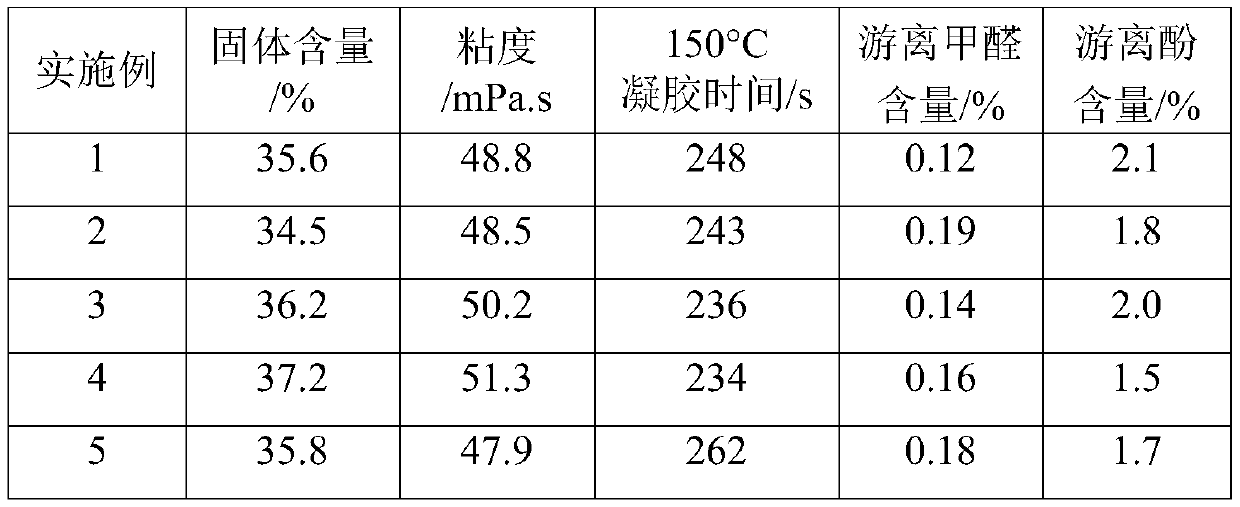Water-soluble modified phenolic resin for bamboo impregnation and preparation method thereof
A phenolic resin and water-soluble technology, which is applied in the field of water-soluble modified phenolic resin impregnated with bamboo and its preparation, can solve the problems of increased water content, affecting the hot-pressing performance of bamboo, and difficulty in curing completely, so as to achieve fast curing speed and benefit For impregnation, effect of low curing temperature
- Summary
- Abstract
- Description
- Claims
- Application Information
AI Technical Summary
Problems solved by technology
Method used
Image
Examples
Embodiment 1
[0034] Add 1000kg of industrial phenol, 1000kg of 37% industrial formaldehyde in the first batch, 100kg of urea in the first batch and 80kg of industrial methanol in the reaction kettle, stir for 20min; heat up to 55°C, keep warm at this temperature for 30min, and gradually add the first Batch 30% sodium hydroxide 400kg (add within 30min), keep the temperature at 55°C when adding, turn on cooling water to cool if necessary, after adding, keep the temperature at 55°C for 30min; add the second batch of industrial formaldehyde solution 600kg , heat up to 80°C, heat preservation reaction for 30min; gradually add the second batch of 30% sodium hydroxide aqueous solution 600kg (completely added within 30min), heat up to 90°C, add the second batch of urea 60kg, heat preservation reaction for 40min, use 10 Add 2800 kg of water after measuring the viscosity at 25° C. for 2 seconds, and then add 2800 kg of water, stir for 30 minutes; pass cooling water, quickly cool down to 38° C., and d...
Embodiment 2
[0036] Add 1000kg of industrial phenol, 1200kg of 37% industrial formaldehyde in the first batch, 120kg of urea in the first batch and 70kg of industrial methanol in the reaction kettle, stir for 22min; heat up to 56°C, keep warm at this temperature for 35min, and gradually add the first Batch 30% sodium hydroxide 500kg (add within 30min), keep the temperature at 56°C when adding, turn on cooling water to cool if necessary, after adding, keep the temperature at 56°C for 35min; add the second batch of industrial formaldehyde solution 800kg , heat up to 81°C, heat preservation reaction for 35min; gradually add the second batch of 30% sodium hydroxide aqueous solution 500kg (completely added within 30min), heat up to 91°C, add the second batch of urea 50kg, heat preservation reaction for 50min, use 10 Add 3000 kg of water after measuring the viscosity at 25° C. for 2 seconds, and then add 3000 kg of water, stir for 35 minutes; pass cooling water, quickly cool down to 38° C., and d...
Embodiment 3
[0038] Add 1000kg of industrial phenol, 950kg of 37% industrial formaldehyde in the first batch, 60kg of urea in the first batch and 60kg of industrial methanol in the reaction kettle, stir for 25min; raise the temperature to 57°C, keep it warm for 40min at this temperature, and gradually add the first Batch 300% potassium hydroxide 300kg (add within 30min), keep the temperature at 57°C when adding, turn on cooling water to cool if necessary, after adding, keep the temperature at 57°C for 40min; add the second batch of industrial formaldehyde solution 900kg , heat up to 82°C, heat preservation reaction for 40min; gradually add the second batch of 30% potassium hydroxide aqueous solution 700kg (completely added within 30min), heat up to 92°C, add the second batch of urea 120kg, heat preservation reaction for 60min, use 10 Add 3500 kg of water after measuring the viscosity at 25° C. for 2 seconds, and then add 3500 kg of water, stir for 40 minutes; pass cooling water, quickly coo...
PUM
| Property | Measurement | Unit |
|---|---|---|
| Viscosity | aaaaa | aaaaa |
| Gel time | aaaaa | aaaaa |
| Solid content | aaaaa | aaaaa |
Abstract
Description
Claims
Application Information
 Login to View More
Login to View More - Generate Ideas
- Intellectual Property
- Life Sciences
- Materials
- Tech Scout
- Unparalleled Data Quality
- Higher Quality Content
- 60% Fewer Hallucinations
Browse by: Latest US Patents, China's latest patents, Technical Efficacy Thesaurus, Application Domain, Technology Topic, Popular Technical Reports.
© 2025 PatSnap. All rights reserved.Legal|Privacy policy|Modern Slavery Act Transparency Statement|Sitemap|About US| Contact US: help@patsnap.com

